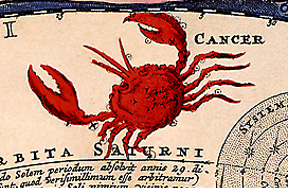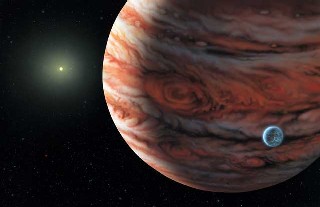This is a picture made by an artist to show what the Jupiter-like planet orbiting the star, 55 Cancri, might look like. We do not have photographs of the planet. It is about forty-one light years away from Earth. The artist added a small moon to the picture although no moon has been found.
Click on image for full size
An Exoplanet that Looks Like Jupiter!
News story originally written on June 18, 2002
A team of astronomers, who have been peering into the skies for many years, announced that they have found 13 planets outside our solar system called exoplanets. This brings the total number of known exoplanets to over 90!
The team is very excited about one of their discoveries. An exoplanet orbiting a star called 55 Cancri, within the Cancer constellation, is very different from any of the others that have been found. Dr Marcy, a leader of the research team, described that, “all other extrasolar planets discovered up to now orbit closer to the parent star, and most of them have had elongated, eccentric orbits. This new planet orbits as far from its star as Jupiter orbits from the Sun.”
Jupiter is about four and a half times further from the Sun than Earth and takes about 12 years to complete one orbit around the Sun. The new planet is a similar distance from its star and takes 13 years to complete one orbit around the star.
The new planet is not exactly like Jupiter, however. It is much more massive than Jupiter. Its orbit is different than Jupiter’s orbit, taking an oval-shaped route around the star instead of a more circular route. Even though the new planet is not exactly like Jupiter, they are similar enough that the research team is hopeful that we may someday find more exoplanets that are like planets in our own solar system.
Last modified June 24, 2002 by Lisa Gardiner.
You might also be interested in:

According to an ancient Greek legend, the figure of a gigantic crab was placed in the nighttime sky by the goddess Hera to form the constellation Cancer. Hera swore to kill Heracles, the most famous Greek
...more
It was another exciting and frustrating year for the space science program. It seemed that every step forward led to one backwards. Either way, NASA led the way to a great century of discovery. Unfortunately,
...more
The Space Shuttle Discovery lifted off from Kennedy Space Center on October 29th at 2:19 p.m. EST. The weather was great as Discovery took 8 1/2 minutes to reach orbit. This was the United States' 123rd
...more
A moon was discovered orbiting the asteroid, Eugenia. This is only the second time in history that a satellite has been seen circling an asteroid. A special mirror allowed scientists to find the moon
...more
Will Russia ever put the service module for the International Space Station in space? NASA officials want an answer from the Russian government. The necessary service module is currently waiting to be
...more
A coronal mass ejection (CME) happened on the Sun early last month. The material that was thrown out from this explosion passed the ACE spacecraft. The SWICS instrument on ACE has produced a new and very
...more
J.S. Maini of the Canadian Forest Service called forests the "heart and lungs of the world." This is because forests filter air and water pollution, absorb carbon dioxide, release oxygen, and maintain
...more















